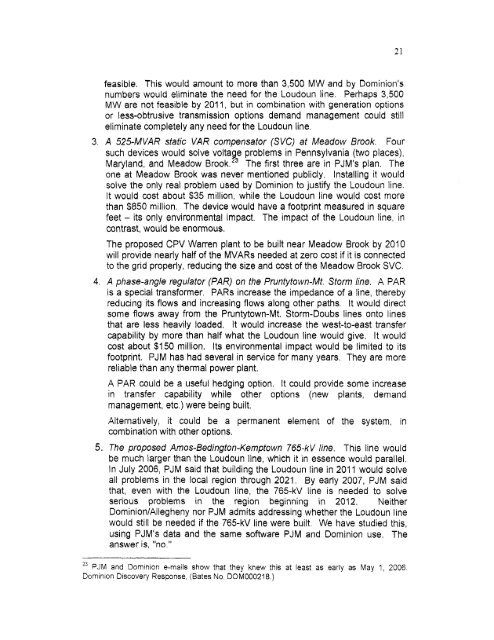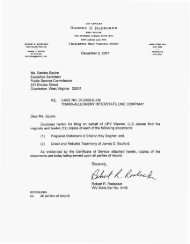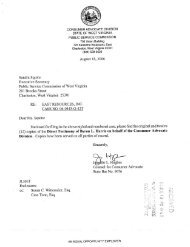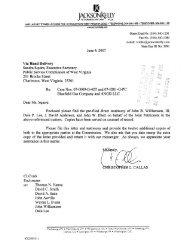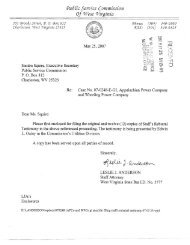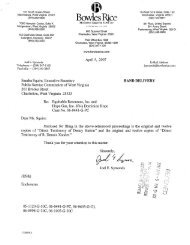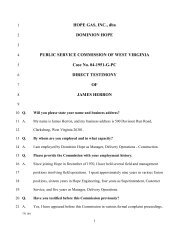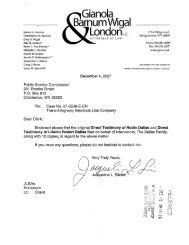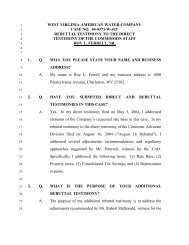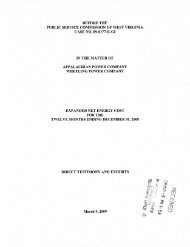Direct Testimony of Thomas M. Hildebrand - Consumer Advocate ...
Direct Testimony of Thomas M. Hildebrand - Consumer Advocate ...
Direct Testimony of Thomas M. Hildebrand - Consumer Advocate ...
You also want an ePaper? Increase the reach of your titles
YUMPU automatically turns print PDFs into web optimized ePapers that Google loves.
21<br />
3.<br />
4<br />
-<br />
feasible. This would amount to more than 3,500 MW and by Dominion's<br />
numbers would eliminate the need for the Loudoun line. Perhaps 3,500<br />
MW are not feasible by 2011, but in combination with generation options<br />
or less-obtrusive transmission options demand management could still<br />
eliminate completely any need for the Loudoun line.<br />
A 525-MVAR static VAR compensator (SVC) at Meadow Brook. Four<br />
such devices would solve voltage problems in Pennsylvania (two places),<br />
Maryland, and Meadow Brook.23 The first three are in PJM's plan. The<br />
one at Meadow Brook was never mentioned publicly. Installing it would<br />
solve the only real problem used by Dominion to justify the Loudoun line.<br />
It would cost about $35 million, while the Loudoun line would cost more<br />
than $850 million. The device would have a footprint measured in square<br />
feet - its only environmental impact. The impact <strong>of</strong> the Loudoun line, in<br />
contrast, would be enormous.<br />
The proposed CPV Warren plant to be built near Meadow Brook by 2010<br />
will provide nearly half <strong>of</strong> the MVARs needed at zero cost if it is connected<br />
to the grid properly, reducing the size and cost <strong>of</strong> the Meadow Brook SVC.<br />
A phase-angle regulator (PAR) on the fruntytown-Mi. Storm line, A PAR<br />
is a special transformer. PARS increase the impedance <strong>of</strong> a line, thereby<br />
reducing its flows and increasing flows along other paths. It would direct<br />
some flows away from the Pruntytown-Mt. Storm-Doubs lines onto lines<br />
that are less heavily loaded. It would increase the west-to-east transfer<br />
capability by more than half what the Loudoun line would give. It would<br />
cost about $150 million. Its environmental impact would be limited to its<br />
footprint. PJM has had several in service for many years. They are more<br />
reliable than any thermal power plant.<br />
A PAR could be a useful hedging option. It could provide some increase<br />
in transfer capability while other options (new plants, demand<br />
management, etc.) were being built,<br />
Alternatively, it could be a permanent element <strong>of</strong> the system, in<br />
combination with other options,<br />
3. The proposed Amos-Bedington-Kemptown 765-kV line. This line would<br />
be much larger than the Loudoun line, which it in essence would parallel.<br />
In July 2006, PJM said that building the Loudoun line in 2011 would solve<br />
all problems in the local region through 2021. By early 2007, PJM said<br />
that, even with the Loudoun line, the 765-kV line is needed to solve<br />
serious problems in the region beginning in 2012. Neither<br />
Dominion/Allegheny nor PJM admits addressing whether the Loudoun line<br />
would still be needed if the 765-kV line were built. We have studied this,<br />
using PJM's data and the same s<strong>of</strong>tware PJM and Dominion use. The<br />
answer is, "no."<br />
23 PJM and Dominion e-rnails show that they knew this at least as early as May 1, 2006.<br />
Dominion Discovery Response, (Bates No DOM000218.)


